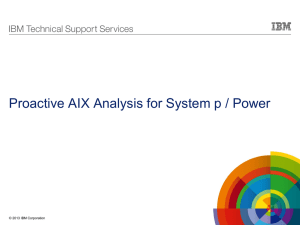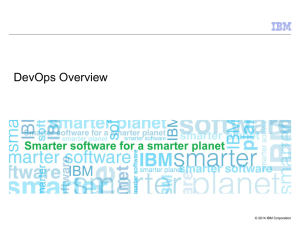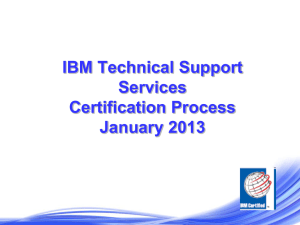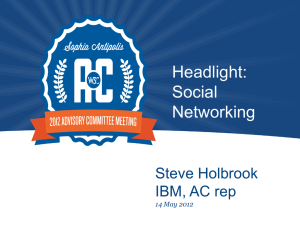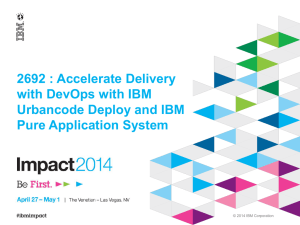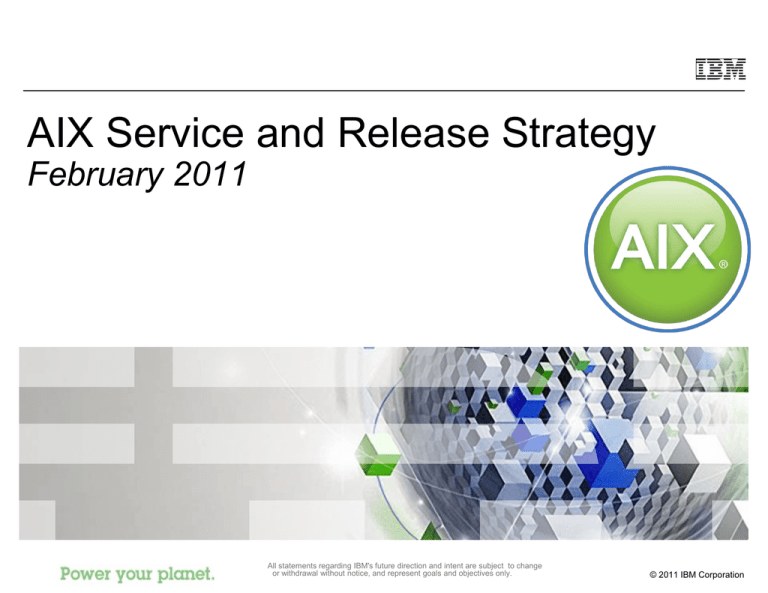
AIX Service and Release Strategy
February 2011
All statements regarding IBM's future direction and intent are subject to change
or withdrawal without notice, and represent goals and objectives only.
© 2011 IBM Corporation
IBM Power Systems
Summary
IBM significantly enhanced the AIX® Release and Service
Delivery strategy in February 2011 for AIX 6 and AIX 7
The principal changes* are:
• Three years of support for each Technology Level (TL)**
• A single Technology Level per AIX version, per year
• Service Packs will be released approximately 4 times per year per
Technology Level
* All statements regarding IBM's future direction and intent are subject to change or withdrawal without notice, and represent goals and
objectives only.
**Due to variations in the release dates of Technology Levels from year to year, some Technology Levels will be supported for slightly more than three
years and some will be supported for slightly less than three years. A three year service life for each Technology Level is an objective, not an absolute
limit. The service life of Technology Levels will also be limited by the end of service life for the underlying AIX release
2
© 2011 IBM Corporation
IBM Power Systems
AIX Technology Level Lifecycle
Approximately 3 years for AIX 6 TL6 and later
No new fixes
Fix Support
Creation of new fixes including
service packs and interim fixes
“How to” Q&A, existing fixes, problem determination
3
End of support for
the AIX release
End of TL new fix support
Availability of the TL
SWMA Standard support period
© 2011 IBM Corporation
IBM Power Systems
AIX Release Strategy* (AIX 6 shown)
2010
Spring
SP
2011
Fall
Spring
SP
SP
SP
2012
Fall
SP
SP
Spring
2013
Fall
Spring
2014
Fall
Spring
SP
SP
New fixes on AIX 6 TL4 and TL5 will
be provided for up to two years
Technology
Level 4
SP
SP
SP
SP
SP
SP
SP
SP
Technology
Level 5
SP
SP
SP
SP
SP
SP
SP
SP
SP
SP
SP
SP
SP
Technology
Level 6
New fixes on AIX 6 TL6 and later
will be provided for up to three years
Legend:
SP
Service Pack -may include new HW support
and AIX fixes
SP
SP
SP
SP
SP
SP
SP
SP
SP
SP
SP
Technology
Level 7
Interim Fix. Interim fixes will continue to be
SP
the method to provide immediate relief for critical
issues pending the release of a Service Pack
SP
SP
SP
SP
SP
SP
New fixes provided for 3 years**
New fixes provided for 2 years
Technology
Level 8
**Due to variations in the release dates of Technology Levels from year to year, some Technology Levels will be supported for slightly more that
New Technology Level - New HW/SW support
and hardware exploitation
4
three years and some will be supported for slightly less A three year service life for each Technology Level is an objective, not an absolute limit. The
service life of Technology Levels will also be limited by the end of service life for the underlying AIX release
*All statements regarding IBM's future direction and intent are subject
© 2011 IBM Corporation
to change or withdrawal without notice, and represent goals and objectives only.
IBM Power Systems
AIX Release Strategy* (AIX 7 shown)
2010
Spring
2011
Fall
Spring
SP
2012
Fall
SP
SP
Spring
SP
SP
2013
Fall
SP
SP
Spring
SP
2014
Fall
SP
SP
SP
Spring
SP
SP
Technology
Level 0
SP
SP
SP
SP
SP
SP
SP
SP
SP
SP
SP
Technology
Level 1
SP
SP
Legend:
SP
SP
Service Pack -may include new HW support
and AIX fixes
SP
SP
SP
SP
Technology
Level 2
Interim Fix. Interim fixes will continue to be
the method to provide immediate relief for critical
issues pending the release of a Service Pack
SP
New fixes provided for 3 years**
SP
New fixes provided for 2 years
Technology
Level 3
New Technology Level - New HW/SW support
and hardware exploitation
5
SP
**Due to variations in the release dates of Technology Levels from year to year, some Technology Levels will be supported for slightly more that
three years and some will be supported for slightly less A three year service life for each Technology Level is an objective, not an absolute limit. The
service life of Technology Levels will also be limited by the end of service life for the underlying AIX release
*All statements regarding IBM's future direction and intent are subject
© 2011 IBM Corporation
to change or withdrawal without notice, and represent goals and objectives only.
IBM Power Systems
Release Strategy Schedule Detail* (AIX 6 shown)
2010
2011
Fall
Spring
2012
Fall
Spring
2013
Fall
Spring
Service packs are planned to be released about every quarter
SP
SP
SP
SP
SP
SP
SP
SP
SP
SP
SP
Technology
Level 6
Service packs for new hardware support on previous Technology Levels will
generally available 60 to 90 days after the availability of the latest TL
SP
SP
Legend:
SP
Service Pack -may include new HW support
and AIX fixes
SP
SP
SP
SP
SP
Technology
Level 7
Interim Fix. Interim fixes will continue to be
the method to provide immediate relief for critical
issues pending the release of a Service Pack
New fixes provided for 3 years**
New fixes provided for 2 years
New Technology Level - New HW/SW support
and hardware exploitation
6
Interim Fixes are created for individual
clients on a “as-needed” basis
*All statements regarding IBM's future direction and intent are subject
to change or withdrawal without notice, and represent goals and objectives only.
© 2011 IBM Corporation
IBM Power Systems
What is not Changing*
IBM’s commitment to Binary Compatibility**
Interim Fixes, Service Packs and Technology Levels all
will still exist
No changes to support life of AIX Releases or release
schedules
** Information and restrictions concerning binary compatibility may be found at
http://www.ibm.com/systems/power/software/aix/compatibility/index.html
7
*All statements regarding IBM's future direction and intent are subject
to change or withdrawal without notice, and represent goals and objectives only.
© 2011 IBM Corporation
IBM Power Systems
Recommended Client Strategy: Once per Year Update*
2010
2011
Fall
Spring
AIX Updates*
SP1
SP2
SP3
2012
Fall
Spring
SP4
SP5
Technology
Level 6
6100.06
SP6
SP1
SP7
SP2
2013
Fall
Spring
SP8
SP3
SP10
SP4
SP11
SP5
SP12
SP6
SP7
TL 7
6100.07
SP1
SP2
SP3
TL8
6100.08
Potential Client Adoption Schedule
SP3
SP3
Technology
Level 6
6100.06
Technology
Level 7
6100.07
Once per year update implements the previous Technology Level plus the latest
Service Pack available for that TL.
Depending on the length of the client certification cycle, the client will be able to
get new fixes on their environment for more than two years
8
*All statements regarding IBM's future direction and intent are subject
to change or withdrawal without notice, and represent goals and objectives only.
© 2011 IBM Corporation
IBM Power Systems
New hardware support strategies*
2010
2011
Fall
Spring
SP1
SP2
SP3
2012
Fall
SP4
Spring
SP5
AIX Updates*
Technology
Level 6
6100.06
SP6
SP1
SP7
SP2
2013
Fall
SP8
SP3
Spring
SP10
SP4
SP11
SP5
SP12
SP6
SP7
TL 7
6100.07
SP1
SP2
SP3
TL8
6100.08
New Hardware
Business as Usual
IBM recommended method
With this method, the client
uses the new hardware with
the latest Technology Level
(if a new TL is available)
New Hardware on a
previous TL
With this method, the client
uses the new hardware
with a previous TL plus the
latest service pack
9
Pro: Greatest exploitation of new hardware
Con: Move up to latest TL required
TL 7
6100.07
Note: Prior TL support may not be available for all new hardware
SP5
Technology
Level 6
6100.06
Pro: Client can use new hardware without upgrading
to the latest TL
Con: May not fully exploit the new hardware, particularly
for the older Technology Levels
*All statements regarding IBM's future direction and intent are subject
to change or withdrawal without notice, and represent goals and objectives only.
© 2011 IBM Corporation
IBM Power Systems
Benefits of the new AIX Release Strategy*
Longer support for Technology Levels
– More closely matches client deployment requirements
Single Technology Level per year, per version, and about
one Service Pack per quarter
– Fewer updates reduce administrative workload
New hardware is supported on prior Technology Levels
– Easier integration of new hardware into existing environments
For more information and best practices see:
https://www14.software.ibm.com/webapp/set2/sas/f/best/home.html
10
*All statements regarding IBM's future direction and intent are subject
to change or withdrawal without notice, and represent goals and objectives only.
© 2011 IBM Corporation
IBM Power Systems
© International Business Machines Corporation 2011
11
All Rights Reserved
© 2011 IBM Corporation
IBM Power Systems
Backup Charts
12
© 2011 IBM Corporation
IBM Power Systems
Question & Answer
Q: Why did you make these changes?
A: The historical purpose for multiple Technology Levels per year was to support the introduction of new
hardware. The support for new hardware on prior TLs (implemented in 2007) and exploited with the
introduction of POWER7 allowed us to do away with the “Spring” TL.
Q: Will I always have to move up to the latest Service Pack in order to get an Interim Fix?
A: Interim Fixes are intended to provide an immediate, short term solution to a specific problem. The intent
is to provide Interim Fixes without requiring clients to apply the latest service pack, but there are cases
where there might be a dependency on a Service Pack that would require applying a Service Pack
before an Interim Fix, but that is intended to be an exception.
Q: Why are you including Hardware in Service Packs – aren’t you introducing additional risk by including
new hardware support in the fix stream?
A: No. When we analyzed historical problems in AIX, we found that new hardware support was not a big
contributor to problems within AIX. Most new hardware only requires a minor change to configuration
tables within AIX or, in some cases, a new fileset for new hardware, neither of which would typically be
a problem for existing clients.
13
*All statements regarding IBM's future direction and intent are subject
© 2011 IBM Corporation
to change or withdrawal without notice, and represent goals and objectives only.
IBM Power Systems
Question & Answer
Q: Why is the a delay in shipping the Service Packs on the old Technology Levels to support new
hardware?
A: It takes time to verify (test) the new service packs on the new hardware. Because we are supporting
up to six Technology Levels/Service Pack combinations for every new piece of hardware, we cannot
test all levels simultaneously. We focus on testing the new Technology Level (which may include new
software features) and then verify the hardware on the older Technology Levels.
Q: How will I get a fixes – right now, if security APAR comes out, it is only released for the latest current
level.
A: There will be APARs released for each Technology Level. These APARs will be cross referenced to
each other.
Q: Why doesn’t the new strategy include AIX V5.3?
A: AIX V5.3 is nearing end of life with the End of Marketing for AIX V5.3 set for April 2011.
Q: I am currently running AIX 6 TL5. Can I stay on this release for three years?
A: No. The new release strategy becomes effective with AIX 6 Technology Level 6 (TL6).
Q: How will I get bootable media for new hardware on previous Technology Levels?
A: A PRPQ will be available to allow clients to order bootable media to support new installation of AIX on
new hardware for previous Technology Levels.
14
*All statements regarding IBM's future direction and intent are subject
to change or withdrawal without notice, and represent goals and objectives only.
© 2011 IBM Corporation
IBM Power Systems
Interim Fix Guidelines/Policies for Maintenance*:
If a client is at the latest level and find a problem – they can get an Interim Fix
If a client finds a problem that is already in a SP - they need to install the latest SP
(or, at a minimum, an SP that includes their fix)
If it is a critical problem and/or the client can't install a SP - an interim fix can be
offered and support will recommend they move to the latest SP during their next
maintenance window
If a client finds a new, unique problem at any supported level (within the 3 year
support window for a TL) - they can get an Interim Fix on their current level (if it's
possible)
If a client finds a new unique problem on a prior SP, has multiple Interim Fixes
installed, which are included in later SP - they must move to the latest SP before
getting another Interim Fix
If a client has multiple Interim Fixes and only some of them are in a later SP - they
must move to the latest SP and another Interim Fix will be bundled with their prior
Interim Fixes on the current level
15
*All statements regarding IBM's future direction and intent are subject
to change or withdrawal without notice, and represent goals and objectives only.
© 2011 IBM Corporation
IBM Power Systems
Special Notices
This document was developed for IBM offerings in the United States as of the date of publication. IBM may not make these offerings available in
other countries, and the information is subject to change without notice. Consult your local IBM business contact for information on the IBM
offerings available in your area.
Information in this document concerning non-IBM products was obtained from the suppliers of these products or other public sources. Questions
on the capabilities of non-IBM products should be addressed to the suppliers of those products.
IBM may have patents or pending patent applications covering subject matter in this document. The furnishing of this document does not give
you any license to these patents. Send license inquires, in writing, to IBM Director of Licensing, IBM Corporation, New Castle Drive, Armonk, NY
10504-1785 USA.
All statements regarding IBM future direction and intent are subject to change or withdrawal without notice, and represent goals and objectives
only.
The information contained in this document has not been submitted to any formal IBM test and is provided "AS IS" with no warranties or
guarantees either expressed or implied.
All examples cited or described in this document are presented as illustrations of the manner in which some IBM products can be used and the
results that may be achieved. Actual environmental costs and performance characteristics will vary depending on individual client configurations
and conditions.
IBM Global Financing offerings are provided through IBM Credit Corporation in the United States and other IBM subsidiaries and divisions
worldwide to qualified commercial and government clients. Rates are based on a client's credit rating, financing terms, offering type, equipment
type and options, and may vary by country. Other restrictions may apply. Rates and offerings are subject to change, extension or withdrawal
without notice.
IBM is not responsible for printing errors in this document that result in pricing or information inaccuracies.
All prices shown are IBM's United States suggested list prices and are subject to change without notice; reseller prices may vary.
IBM hardware products are manufactured from new parts, or new and serviceable used parts. Regardless, our warranty terms apply.
Any performance data contained in this document was determined in a controlled environment. Actual results may vary significantly and are
dependent on many factors including system hardware configuration and software design and configuration. Some measurements quoted in this
document may have been made on development-level systems. There is no guarantee these measurements will be the same on generallyavailable systems. Some measurements quoted in this document may have been estimated through extrapolation. Users of this document
should verify the applicable data for their specific environment.
Revised September 26, 2006
16
© 2011 IBM Corporation
IBM Power Systems
Special Notices (Cont.)
The following terms are registered trademarks of International Business Machines Corporation in the United States and/or other countries: AIX, AIX/L,
AIX/L(logo), alphaWorks, AS/400, BladeCenter, Blue Gene, Blue Lightning, C Set++, CICS, CICS/6000, ClusterProven, CT/2, DataHub, DataJoiner, DB2,
DEEP BLUE, developerWorks, DirectTalk, Domino, DYNIX, DYNIX/ptx, e business(logo), e(logo)business, e(logo)server, Enterprise Storage Server, ESCON,
FlashCopy, GDDM, i5/OS, IBM, IBM(logo), ibm.com, IBM Business Partner (logo), Informix, IntelliStation, IQ-Link, LANStreamer, LoadLeveler, Lotus, Lotus
Notes, Lotusphere, Magstar, MediaStreamer, Micro Channel, MQSeries, Net.Data, Netfinity, NetView, Network Station, Notes, NUMA-Q, OpenPower,
Operating System/2, Operating System/400, OS/2, OS/390, OS/400, Parallel Sysplex, PartnerLink, PartnerWorld, Passport Advantage, POWERparallel, Power
PC 603, Power PC 604, PowerPC, PowerPC(logo), Predictive Failure Analysis, pSeries, PTX, ptx/ADMIN, RETAIN, RISC System/6000, RS/6000, RT
Personal Computer, S/390, Scalable POWERparallel Systems, SecureWay, Sequent, ServerProven, SpaceBall, System/390, The Engines of e-business,
THINK, Tivoli, Tivoli(logo), Tivoli Management Environment, Tivoli Ready(logo), TME, TotalStorage, TURBOWAYS, VisualAge, WebSphere, xSeries, z/OS,
zSeries.
The following terms are trademarks of International Business Machines Corporation in the United States and/or other countries: Advanced Micro-Partitioning,
AIX, AIX PVMe, AS/400e, Chiphopper, Chipkill, Cloudscape, DB2 OLAP Server, DB2 Universal Database, DFDSM, DFSORT, DS4000, DS6000, DS8000, ebusiness(logo), e-business on demand, eServer, Express Middleware, Express Portfolio, Express Servers, Express Servers and Storage, General Purpose File
System, GigaProcessor, GPFS, HACMP, HACMP/6000, IBM TotalStorage Proven, IBMLink, IMS, Intelligent Miner, iSeries, Micro-Partitioning, NUMACenter,
On Demand Business logo, POWER, PowerExecutive, Power Architecture, Power Everywhere, Power Family, Power PC, PowerPC Architecture, PowerPC
603, PowerPC 603e, PowerPC 604, PowerPC 750, POWER2, POWER2 Architecture, POWER3, POWER4, POWER4+, POWER5, POWER5+, POWER6,
POWER6+, pure XML, Redbooks, Sequent (logo), SequentLINK, Server Advantage, ServeRAID, Service Director, SmoothStart, SP, System i, System i5,
Power Systems, Power Systems5, System Storage, System z, System z9, S/390 Parallel Enterprise Server, Tivoli Enterprise, TME 10, TotalStorage Proven,
Ultramedia, VideoCharger, Virtualization Engine, Visualization Data Explorer, X-Architecture, z/Architecture, z/9.
A full list of U.S. trademarks owned by IBM may be found at: http://www.ibm.com/legal/copytrade.shtml.
UNIX is a registered trademark of The Open Group in the United States, other countries or both.
Linux is a trademark of Linus Torvalds in the United States, other countries or both.
Microsoft, Windows, Windows NT and the Windows logo are registered trademarks of Microsoft Corporation in the United States, other countries or both.
Intel, Itanium, Pentium are registered tradas and Xeon is a trademark of Intel Corporation or its subsidiaries in the United States, other countries or both.
AMD Opteron is a trademark of Advanced Micro Devices, Inc.
Java and all Java-based trademarks and logos are trademarks of Sun Microsystems, Inc. in the United States, other countries or both.
TPC-C and TPC-H are trademarks of the Transaction Performance Processing Council (TPPC).
SPECint, SPECfp, SPECjbb, SPECweb, SPECjAppServer, SPEC OMP, SPECviewperf, SPECapc, SPEChpc, SPECjvm, SPECmail, SPECimap and SPECsfs
are trademarks of the Standard Performance Evaluation Corp (SPEC).
NetBench is a registered trademark of Ziff Davis Media in the United States, other countries or both.
AltiVec is a trademark of Freescale Semiconductor, Inc.
Cell Broadband Engine is a trademark of Sony Computer Entertainment Inc.
Other company, product and service names may be trademarks or service marks of others.
Revised February 14, 2007
17
© 2011 IBM Corporation


